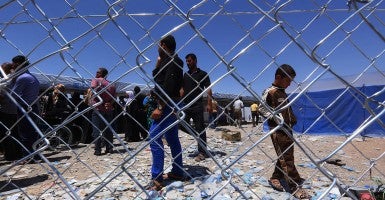Foreign fighters—outsiders recruited or who volunteer to fight in another country for somebody else’s cause—are nothing new. What’s new is that they have become a staple of the Al Qaeda cohort.
It’s called the “pipeline” problem. Ferrying warriors to the war and also returning them home to spread the war elsewhere has become part of the stock and trade of how transnational terrorists do business. The new front in Iraq creates new opportunities for another wave of attacks against the West, either from “lone wolves” or cells organized or supported by the veteran extremists.
Rallying to fight for a cause has deep historic roots. Teddy Roosevelt rallied his “Rough Riders.” During the Spanish Civil War, Americans joined the Lincoln Brigade to fight the fascists. In 1947, West Pointer Mickey Marcus served as military adviser to David Ben-Gurion and the Haganah, fighting for Israeli independence.
While the notion of outsiders joining armed groups isn’t an innovation, integrating the practice into building a global Islamist terrorist network has become the scourge of the twenty-first century.
The Soviet invasion of Afghanistan in 1979 proved a transformative moment for the nascent Islamist activist web that seeks to stitch together the like-minded. The shadowy Haqqanis in Pakistan, write Vahid Brown and Don Rassler in Fountainhead of Jihad¸ “introduced an innovation in their appeals to the Arab world that would have fateful consequences in years to come… the Haqqanis made direct calls for foreign fighter volunteers.” Then they helped establish the logistics network to turn the call into action. They brought Osama bin Laden into the fight.
When bin Laden returned to Afghanistan in 1996, as the 9/11 Commission documented, he established training camps for foreign fighters. “Many of the operatives in the African Embassy and Cole attacks attended training camps in Afghanistan, as did all nineteen of the 9/11 hijackers,” the reported noted.
Al Qaeda organized a pipeline to bring foreign fighters into the chaos after the U.S. liberation of Iraq. A research project by the Countering Terrorism Center at West Point documented some of their operations.
Since then, the pipeline has been a staple wherever Al Qaeda or its affiliates have opened a new battlefront throughout the Middle East and North Africa. Fighters flocking from Western Europe to fight against the Assad regime in Syria were of particular concern to Western intelligence and security officials.
By all accounts, the pipeline is piping along these days as ISIS floods in Iraq. Not only are the practice and techniques proven and well known, but extremists groups are also becoming much more aggressive, using social media for propaganda, which in turn helps boost recruiting and fund raising.
The United States can plan on two tasks for its future efforts combating transnational terrorism.
First, there is bound to be a new wave of transnational terrorist attacks. That is one big problem. The Obama counterterrorism strategy has predictably failed. Into that void, Al Qaeda and its affiliates will push for the next offensive against the West. To make matters worse, the homeland-security enterprise created after 9/11 to deal with this threat is not in the best of shape. It’s distracted with immigration and borders issues, while many key programs—from Real ID to terrorist watch lists—are under siege from critics, Congress and the courts.
Second, the fact that extremists are so adept at setting up these pipelines, even though the West knows this is a predictable tactic, suggests that the United States and its allies are doing a pretty poor job of anticipating and degrading them. The United States ought to be spearheading a global strategy to preemptively choke off foreign-fighter pipelines, rather than finding out on CNN that they’re popping up.
Originally posted on National Interest.































